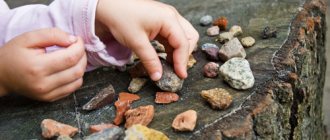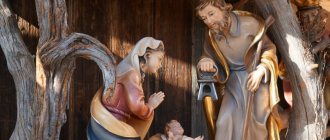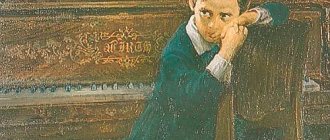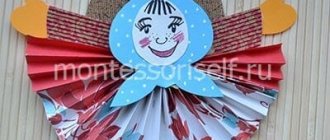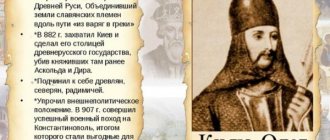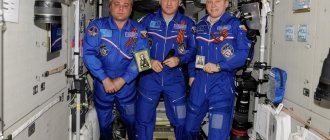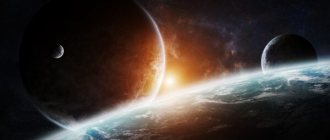Astronomy for children > Solar system > Planet Earth > Moon
The Moon is a natural satellite of the Earth : description for children with photos: interesting facts, characteristics, orbit, map of the Moon, USSR research, Apollo, Neil Armstrong.
or teachers at school start explaining to children by saying that the earth’s satellite is incredibly easy to detect. The Earth has a single Moon that accompanies us almost every night. Lunar phases have controlled humanity for thousands of years, forcing them to adapt (a calendar month is approximately equal to the time it takes for the Moon to change phases).
The phases of the Moon and its orbit remain a mystery to many. You can explain to children that the Moon always shows one face to our planet. The fact is that for an axial rotation and around the planet it takes 27.3 days. We notice the full moon, crescent moon and new moon because the satellite reflects sunlight. The level of illumination depends on the location of the satellite in relation to us and the star.
The moon has a powerful influence on us and may even be the reason for the emergence of life.
The Moon is a natural satellite of the Earth, but it is larger than Pluto (diameter - 3475 km) and occupies 27% of the Earth's size (ratio of approximately 1:4). This is a much smaller ratio than the situation with other moons and their planets.
How the Moon appeared - an explanation for children
for the little ones to know that there are several theories about this. But the most popular one focuses on the collision that tore material away from the Earth . Scientists suggest that the impact object had 10% of the Earth's mass (like Mars ). The pieces orbited until they formed the Moon. This idea is also supported by the fact that the composition of the planet and the satellite are very similar. This could have happened 95 million years after the formation of our system (give or take 32 million).
This is the prevailing theory, but there is also another that suggests that there were originally two moons that merged into one when they collided. Moreover, our planet could even pull over a satellite from Venus .
Does the Moon have an atmosphere?
There is an atmosphere on the Moon - this is a fact, but it is so highly discharged that it can easily be ignored - this is also a fact.
One of the sources of the lunar atmosphere are gases that are released from the lunar crust, such gases include radon gas. Another source of gases in the lunar atmosphere are gases released when the lunar surface is bombarded by micrometeorites and the solar wind.
Due to the weak magnetic and gravitational field of the Moon, almost all gases from the atmosphere escape into outer space.
The internal structure of the Moon - an explanation for children
Children should know that our satellite has a very small core (only 1-2% of the lunar mass) - 680 km in width. It is primarily composed of iron, but may contain significant amounts of sulfur and other elements.
The rocky mantle covers 1,330 km and is represented by rocks rich in iron and magnesium. Magma has been erupting to the surface through volcanoes for over a billion years (from 3-4 billion years ago).
The thickness of the crust is 70 km. The outer part is broken and mixed due to severe impacts. Intact material begins at approximately 9.6 km.
Where do lunar craters come from?
On the surface of the Moon we can observe craters - evidence of bombardment of its surface by asteroids, comets and meteorites. There are about half a million craters larger than 1 km in size.
Due to the absence of an atmosphere, water and significant geological processes on the Moon, the lunar craters were virtually unchanged and even ancient craters were preserved on its surface. The largest crater on the Moon is located on the far side of the Moon; it measures 2240 km in diameter and 13 km deep.
Composition of the Moon's surface - an explanation for children
Parents or at school can explain to the youngest children that our satellite is a rocky world. It has many craters created by asteroid impacts millions of years ago. Since there is no weather there, they are preserved in their original form.
This image of the lunar surface was taken by Apollo 10 astronauts in May 1969.
Composition by weight: oxygen (43%), silicon (20%), magnesium (19%), iron (10%), calcium (3%), aluminum (3%), chromium (0.42%), titanium (0.18% ) and manganese (0.12%).
Traces of water were found on the lunar surface, which could have appeared from the depths. Also, hundreds of pits were found there, where there were devices that had been on the satellite for a long period of time.
Is there water on the Moon?
No water was found in samples of lunar rock brought to Earth by astronauts participating in the Apollo mission and by Soviet lunar rovers.
However, we do know that the surface of the Moon has been bombarded by comets since its formation, and comet nuclei are known to be mostly made of ice. True, this does not add optimism - under the influence of solar radiation, water atoms should have disintegrated into hydrogen and oxygen atoms and, due to the weak gravity of the Moon, simply evaporated into outer space.
However, there is another point of view: as a result of mapping the surface of the Moon by the Clementine satellite, launched by NASA in 1994, craters were discovered in the polar regions of the Moon, which are always in the shadow, and in which water in the form of ice could be preserved.
Due to the great importance of the availability of water for the future colonization of the Moon, lunar bases are planned to be located in the circumpolar regions of our satellite.
The internal structure of our planet's satellite - the Moon
Orbital path of the Moon - explanation for children
Children should know that the moon's gravity affects our planet by causing sea levels to rise and fall (high and low tides). To a lesser, but still noticeable, extent, this is manifested in lakes, the atmosphere and the earth's crust.
The water rises and falls. On the side facing the Moon, the tide is stronger. But even on the second one it occurs by inertia, so low tides are created between these two points. The Moon also slows down the rotation of our planet (tidal braking). This increases the length of the day by 2.3 milliseconds each eyelid. The energy is absorbed by the Moon and increases the distance between us. That is, for the little ones it is important to learn that the satellite moves away by 3.8 cm every year.
View of the Earth from the surface of the Moon
Perhaps it was lunar gravity that caused the formation of the Earth as a planet suitable for life. It moderated fluctuations in axial tilt, allowing a stable climate to persist for billions of years. But the satellite did not stand aside, since the earth’s gravity once stretched it to incredible shapes.
Why is the Moon always visible from only one side?
There is no secret here: the periods of revolution of the Moon around its own axis and around the Earth are the same, and for this reason the Moon faces the Earth all the time with only one side. In other words, the Moon “turns” at the same speed as it “flies” in our sky, so at the same moment in time we can observe the same picture on its surface.
At the same time, it is not entirely correct to say that we see “one side” of our planet’s satellite - in fact, about 59% of the Moon’s surface is visible from the earth, that is, almost two-thirds of the lunar disk. We call that part of the Moon that is not visible to an observer from Earth the far side of the Moon .
The far side of the Moon was first photographed by the Soviet lunar station Luna 3 in 1959.
The visible side of the Moon (left) and the far side of the Moon (right)
Seasons - explanation for children
The Earth's axis is tilted relative to the plane of the ecliptic (the imaginary surface of the orbit around the Sun). An explanation for children cannot do without deciphering this moment. southern hemispheres take turns pointing to the Sun. This results in different amounts of light and heat being received – the change of seasons.
The Earth's axis is tilted by 23.5 degrees, and the Moon's by 1.5. It turns out that there are practically no seasons on the satellite. Some areas are always lit, while others live forever in the shadows.
Purpose of the lesson:
Form an idea of the Moon as a cold celestial body of a spherical shape. Learn to compare and generalize. Talk about the relief of the lunar surface and the peculiarities of environmental conditions on it.
Activate vocabulary:
craters, new moon, full moon
Equipment:
application “Solar system” for each child; a small ball with an elastic band; costume of the queen of space (black cape embroidered with stars and planets, hat); circles of yellow self-adhesive paper; three circles of the same color but different sizes; stars made of shiny paper according to the number of children; three-dimensional figures of various shapes; globe, 2 sheets of whatman paper with circles drawn on them; container with sand; stones according to the number of children; "moon dust"; pipes; flashlight; pictures depicting various things and objects; paper circles depicting the phases of the moon.
Preliminary work:
conducting a lesson on the topic “Solar System”; conducting an application on the topic “Composition of the solar system”; observing the changing phases of the moon.
Progress of the lesson
A teacher in a black cape embroidered with stars and planets and the same hat comes to the children and informs them that the Queen of Space has come to visit them. She wants to find out what the children know about her kingdom.
Queen of Space
. Guys, try to characterize my kingdom, what is it like?
Children
. Cold, dark, huge, shiny, etc.
Queen of Space
: Now I want to ask you a riddle:
Night comes - She rises. It shines in the sky, dispels the darkness. (Moon)
Queen of Space:
Well done boys. Did you know that Luna is my youngest daughter.
Try to find a place for the Moon in my cosmic kingdom and remember that it is part of the solar system. ( Gives each child a circle of self-adhesive yellow paper and the “Solar System” applique, made by everyone in previous lessons (you can use the “Solar System” poster, but then only one child can complete the task). Children find an image of the planet Earth and glue a model of the Moon near her. If children find it difficult, the Queen of the Cosmos helps them.)
Then the Queen of Space invites the children to approach the previously prepared three-dimensional figures of various shapes and choose only those that resemble the Moon in shape. Children complete the task by choosing spherical objects. Once again they clarify together that the Moon has the shape of a ball.
Queen of Space
. Everyone in my kingdom is so restless. You can’t keep anyone in place, everyone is moving and moving. So my youngest daughter hangs around her friend – the Earth. Let's see how this happens.
Demonstration:
A globe is placed in advance on a separate table.
The Queen of Space takes the prepared model of the Moon on an elastic band and demonstrates the movement of the Moon around the Earth. Queen of Space:
Now try to show yourself how this happens.
Outdoor game
: Children are divided into pairs. One child acts as a model of the Moon, the other - the Earth. They demonstrate the movement of the Moon around the Earth. At the same time, the child representing the Earth also moves around its axis.
Queen of Space:
For this, the Moon was even nicknamed the Earth's satellite. What do you think the word satellite means? The Earth attracts the Moon to itself and does not allow it to move away. Here, look.
Demonstration:
The Queen of Space demonstrates the gravitational force of the Moon on the Earth.
Explains to the children that she plays the role of the Earth. He throws a ball on an elastic band, the elastic band tightens, the ball comes back. It is the force of gravity that made the Moon an eternal satellite of the Earth. Then the Queen of the Cosmos shows the children circles of different sizes and colors and asks them to show which of them corresponds in size to the Moon, which to the Earth, and which to the Sun. Clarifies that the Moon is much smaller than the Sun and smaller than the Earth. Then the queen of space again invites the children to look at their “Solar System” applications and determine what is located further from the Earth, the Moon or the Sun.
Queen of Space
: Guys, would you like to take a closer look at what is there on the Moon? Let's fly there. Shall we fly straight in these clothes? Why not? What should you wear for space travel? To make the flight successful, here's a magic star for you all. They will help you during the flight. So, close your eyes and say the spell:
10, 9, 8, 7, 6, 5, 4, 3, fly into starry space.
Imagination game
: The Queen of Space asks the children what they observe around them during the flight. (Children fantasize with their eyes closed.) Attention, get ready, we're about to land on the moon! (Children open their eyes and see in front of them either a model or an image of the lunar surface).
Queen of Space
. The surface of the Moon is covered with the finest sand, lunar dust, like this (shows). Then he lays out two sheets of whatman paper with circles drawn on it and invites the children to sprinkle “moon dust” on both circles. The Queen of Space makes indentations in the sand with her fingers and explains that these traces were left by astronauts who landed on the surface of the Moon.
Queen of Space
. The fact is, guys, that there is no air at all on the Moon. And you and I know that wind is... air movement. If the wind blew on the Moon, then these traces... Let's see what would happen to them. How can you create wind? That's right, blow it. Children blow, traces disappear. Now let's look at the adjacent sheet. Due to the fact that there is no wind on the Moon, the footprints of the astronauts will remain on it forever.
Queen of space.
And on the surface of the moon there are high mountains, much higher than on Earth (puts plasticine mountains) on the model and deep holes (craters). There are no such deep depressions on Earth. Scientists have found that they were formed from the fall of meteorites on the surface of the planet. Let's try to see how this happens.
Experience:
The teacher hands out stones to the children and tells them that they are meteorites. He suggests reproducing the process of falling meteorites by throwing stones into a container with “moon dust” ( the sand can be slightly moistened with water
). Falling stones create holes.
Queen of Space:
Have you watched the Moon?
Do we always see the Moon as a full circle? And the sun? Have you ever wondered why this happens? ( as a rule, children find it difficult to answer this question
). Then the Queen of the Cosmos explains that the sun, like an electric light bulb, itself emits light, and the Moon only reflects the light of the sun. Offers to demonstrate experience.
Experience:
The experiment is carried out in a darkened room. The flashlight plays the role of the sun. The small ball is a model of the Moon. One of the children holds a model of the Moon in his hands. When the flashlight is not turned on (the sun does not shine on the surface of the Moon visible from Earth),
children do not see the “Moon”.
As soon as the flashlight turns on (the sun shines on the surface of the Moon visible from the Earth),
the children see the “Moon” in the form of a full circle.
Queen of Space:
There is not only no air on the Moon, but also no water. Think about whether living beings live there? Why?
Since the Moon attracts to its surface weaker than the Earth, you could easily lift such a table on the Moon (points to the table or something else).
On the Moon, without any extra effort, just by jumping up, you could touch this ceiling with your hand.
Also, simply pushing off, they could jump 10-20 m long (from one wall of the room to the other).
Queen of Space:
You have already told me that we see the Moon in different ways.
Sometimes we don't see the Moon at all in the sky. This appearance is called a new moon
(the Queen of Space
places a black circle on the flannelgraph).
A few days later we already see the Moon like this
(places an image of the next lunar phase on the flannelgraph).
A few more days later - like this
(places an image of a quarter of the waxing Moon).
The Queen of the Cosmos draws a line down from it so that the letter P is formed and explains that the Moon is now growing.
In the morning I see from the window, the early moon in the sky. To distinguish it, we need to put a stick on the semicircle and get the letter R there.
After some time we see the Moon like this (places an image of the full Moon)
This type of moon is called a full moon.
Then the Moon will decrease and after a while it will take this form (places an image of a quarter of the waning Moon on the flannelgraph)
. Then the Lunar disk will shrink again and finally take on this form (places an image of the next phase of the Moon). All that will remain of the Moon is a sickle, similar to the letter C. They say that the Moon is waning and aging.
The crescent moon floated across the sky, the crescent bent towards harm. And that’s why the letter S shone from heaven for us. (G. Sapgir)
Consolidation: Didactic game: “Space Traveler”.
Progress of the game.
The Queen of Space tells the children that they can go on a trip to the Moon. For any trip you need to take the necessary things with you. She puts a set of pictures in front of the children and asks them to point out which things might be useful on the moon and which ones might not.
Or maybe build a lunar house?
Living on the moon will be difficult. Yes, of course there are seas and mountains, just like on our home planet. But only in the lunar seas there is no water. These are huge craters left from falling meteorites. There are 17 seas in total. They are also called lunar craters. These are depressions of different sizes from small to huge. We can see one of these craters, called the Eastern Sea, on the lunar disk at night.
The lunar seas have very beautiful names. For example, Sea of Tranquility, Sea of Rains, Sea of Clouds. There is also one ocean, it is called the Ocean of Storms.
The surface of the moon is brownish-gray in color and covered with dust. This dust is very fine, similar to flour, but at the same time very coarse. It can get into the smallest cracks. The astronauts who managed to visit the surface of the satellite complained that it ruined their shoes and got into their spacesuits. And the dust smells like something burnt.
The gravity on our satellite is six times less than that of Earth, so moving on its surface is very difficult. You have to move very slowly.
During the day it is very hot, the temperature reaches +130 degrees. And at night it’s “cool” down to -180. Well, who else wants to build a house on the moon?
Future of the Moon
The Moon is the first cosmic body after Mars that claims priority for human colonization. In a sense, the Moon has already been mastered - the USSR and the USA left state regalia on the satellite, and orbital radio telescopes are hiding behind the far side of the Moon from the Earth, a generator of a lot of interference on the air. However, what does the future hold for our satellite?
The main process, which has already been mentioned more than once in the article, is the moving away of the Moon due to tidal acceleration. It happens quite slowly - the satellite moves away no more than 0.5 centimeters per year. However, something completely different is important here. Moving away from the Earth, the Moon slows down its rotation. Sooner or later, a moment may come when a day on Earth will last as long as a lunar month - 29–30 days.
The collision of the Moon and the Earth as imagined by an artist
However, the removal of the Moon will have its limit. After reaching it, the Moon will begin to move closer to the Earth in turns - and much faster than it was moving away. However, it will not be possible to completely crash into it. 12-20 thousand kilometers from the Earth, its Roche lobe begins - the gravitational limit at which a satellite of a planet can maintain a solid shape. Therefore, the Moon will be torn into millions of small fragments as it approaches. Some of them will fall to Earth, causing a bombardment thousands of times more powerful than nuclear, and the rest will form a ring around the planet like the ring of Saturn. However, it will not be so bright - the rings of gas giants are made of ice, which is many times brighter than the dark rocks of the Moon - they will not always be visible in the sky. The ring of the Earth will create a problem for astronomers of the future - if, of course, there is anyone left on the planet by that time.

